The Value of Weeds
Air Date: Week of July 1, 2016
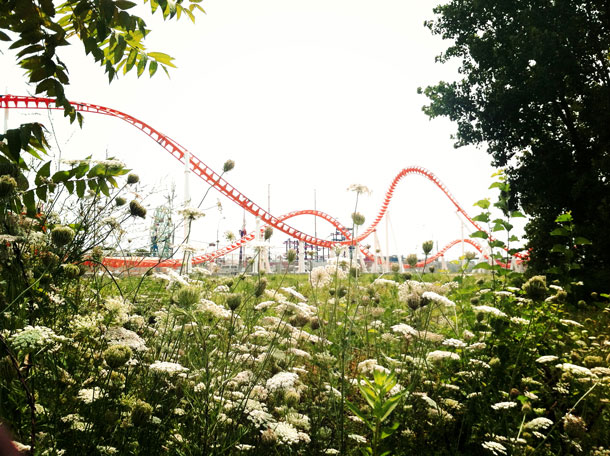
Daucus Carota or Queen Anne’s Lace (Photo: Future Green Studio)
Landscape architect David Seiter is on a mission to emphasize the aesthetic and environmental benefits of what he calls spontaneous urban plants, but what most of us call weeds. David Seiter takes Living on Earth’s Helen Palmer on a tour of Red Hood, Brooklyn, showing off the mugwort and Queen Anne’s Lace and Tree of Heaven that sprout up through and along the sidewalks in this post-industrial neighborhood, and explains their value for cooling the city, conserving water and sequestering carbon.
Transcript
CURWOOD: Summer city dwellers are grateful for the green shade of street trees, the cool refuge of parks and the glimpses of front yards and planters. But most cities also host other plants, that grow with surprising vigor and tenacity, and can also help cool the sizzling sidewalks and concrete. You might be tempted to call them weeds, but landscape architect David Seiter has another name for them – Spontaneous Urban Plants, which is also the name of his new book. Living on Earth’s Helen Palmer went to New York City to check out his ideas in action.
PALMER: Future Green Studio is a landscape architecture firm in Red Hook, Brooklyn, a gritty neighborhood along an old New York City wharf. The company’s founder David Seiter thinks weeds deserve more respect for their virtues, and shows off pictures of a recent project that demonstrates what he means.
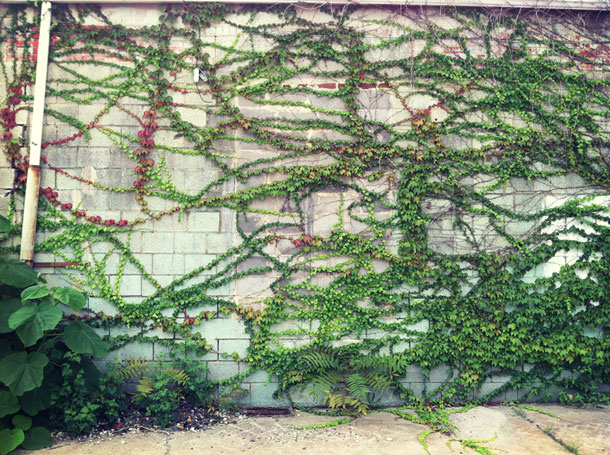
A wall covered in Boston Ivy and Virginia creeper, two spontaneous urban plants that like to colonize the walls of neglected buildings (Photo: Future Green Studio)
SEITER: This is our most recent project that incorporates weeds. It's called Nowadays. It's a beer garden out in Ridgewood, Queens. And what we were tasked with was transforming this 18,000 square foot triangular post-industrial site and really converting into this open park space. And so we left a lot of weeds in situ, you see Ailanthus altissima, tree of heaven, here coming up. There's Japanese knotweed hugging the fence and hugging the edges. There's mulberry plants, and then a lot of the actual plants that we seeded or planted you'd also find growing wild. Things like sumac, chasmanthyum, other plants like golden rod, some of the more aesthetically pleasing weeds.
HELEN: And that there looks like either foxglove or like purple loosestrife?
SEITER: I think that is purple loosestrife, which I would never plant outside the city, and really when you talk about our value and perception of these plants you really have to first start with the site. Not every weed is wonderful, but on a particular site that might be more urban that's already degraded when you're finding it, these plants are actually the most successful and can offer ecological and aesthetic value.
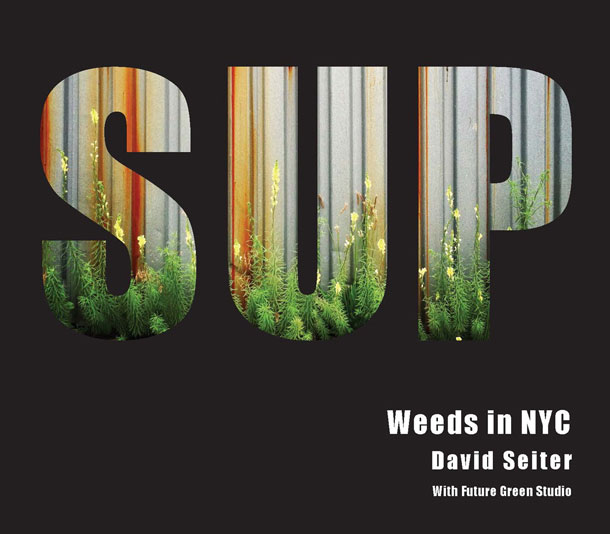
The inspiration for the book “Spontaneous Urban Plants: Weeds in NYC” came from an Instagram-powered art and research project, #spontaneousurbanplants, on the overlooked ecological services that weeds offer in urban environments. (Photo: Future Green Studio)
[DOOR OPENS INTO THE OUTDOORS]
SEITER: We can walk on the shady side or the weedy side. They’re kind of everywhere.
PALMER: Outside on the street, a riot of spontaneous urban plants sprouts up along and through the cracked sidewalks of Redhook. There’s Queen Anne’s Lace, Bittersweet Nightshade, and the ubiquitous Ailanthus, the Tree of Heaven.
SEITER: This plant is also called the tree of Brooklyn, because it was made famous by the book "A Tree Grows in Brooklyn." Ailanthus was intentionally cultivated in the 70s and I think as late as the early 80s, and then they realized its invasive potential, and the fact that is was starting to kind of grow in areas that we really didn't want it to grow. But since it’s become kind of the poster child of weeds, and right now this plant is covering New York City as well as other cities. Yet people aren't really calculating it in their index of urban trees yet there's a forest of them. They just are happening in these more discrete locations, and in locations that we don't really qualify as green space. Things like walls, and streets and sidewalks and roofs. But you really find them as kind of this emergent vegetation everywhere.
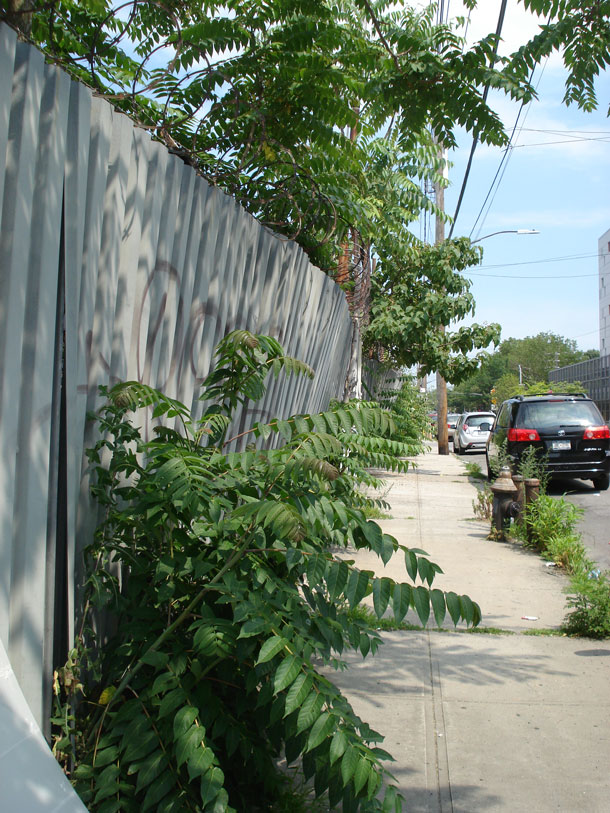
Ailanthus altissima, commonly known as “tree of Heaven”, is a familiar part of American culture thanks to the best-selling novel “A Tree Grows in Brooklyn.” (Photo: Helen Palmer)
PALMER: As we walk, David points out several other weed species: Lambsquarters, horsetail, and the leafy Boston ivy vine, crawling up an abandoned brick warehouse.
SEITER: Because it’s growing on this wall in this neglected space people perceive it as a weed. The same thing happens with Goldenrod, one of my favorite native plants, if you find that in a garden you say ‘what a beautiful flower,’ but when you find it on a vacant lot you're thinking ‘oh it’s coming out at the same time as ragweed, it’s causing hayfever.’ There’s all these negative associations with it.
PALMER: We sit down on a shady park bench under a linden tree, and David talks about his new book. It’s a guide filled with photos and a list of the benefits of these neglected tough plants with names like fleabane, common toadflax, and broadleaf plantain – all of them weeds to most gardeners.
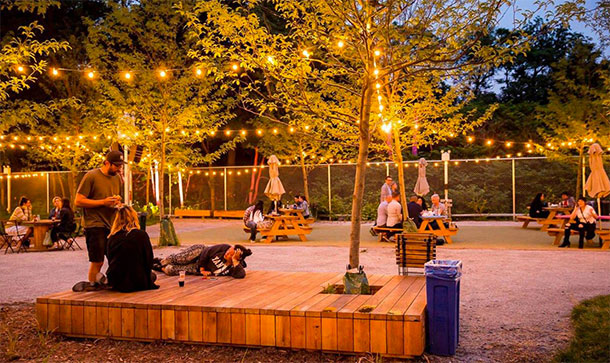
“Nowadays” is a new outdoor hangout spot in Queens, built on a former industrial site and designed by Future Green studio. (Photo: Future Green Studio)
SEITER: My intention is to really rebrand weeds and get people to think about their ecological and performative values. So, we wanted to use the title SUP (Spontaneous Urban Plants) to get people's attention, and really get them to think about what plants might be acceptable in an urban environment.
PALMER: So how did this whole idea of rebranding plants come about? What started it off?
SEITER: Well, we originally worked on a design competition where we wanted to engage the city in a unique way. So what we did was establish transect walks across each of the five boroughs here in New York City and went out in small teams to kind of document the urban plants that we found along the way – then use the digital tool of Instagram to photograph the plants, use the filters available to sensationalize the plants and again, elevate their status and reveal their potential beauty.
PALMER: So basically people sent you snapshots of the weeds they found as they wandered through the city?
SEITER: Right, essentially it is a user-generated database of weeds. So you can go on Instagram, take a picture of an urban weed, hashtag it “spontaneous urban plants.” It gets mapped to our website where we identify it and we've really now created this kind of worldwide mapping of weeds, and what's really fascinating and something that has come out of that research is that there's actually an urban flora which is starting to emerge that is almost like a native condition. It's less about the climate of that particular city or region and more about the urban conditions which it offers. So the same 150 to 200 plants that are growing here New York, many of them are being found in Berlin or in Seoul, South Korea or in the Netherlands. So it's fascinating to see that the urban conditions rather than climate have really started to generate which plant communities exist there.
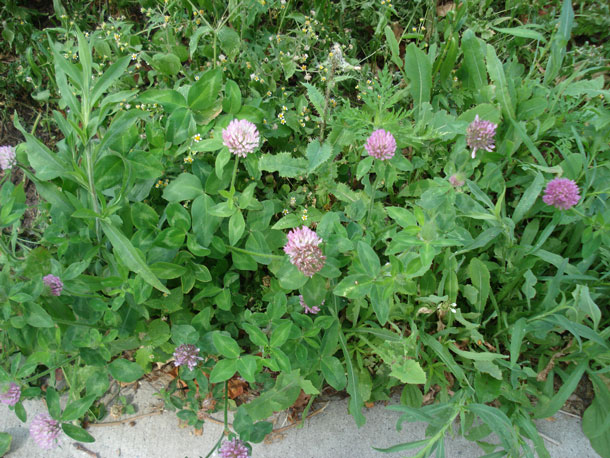
Red clover fixes nitrogen in the soil, helping other plants grow (Photo: Helen Palmer)
PALMER: Now, talking about the kind of weeds, you've got many many different ones...what do you think is particularly lovely, particularly beautiful that we could really look at a little more carefully and not just call a weed?
SEITER: Well, there's so many [LAUGHS]. Where should we choose from? Goldenrod is one of my favorite. White clover I think is a wonderful plant to come and invade our parks and lawns. Red clover is another beautiful plant and it's got night nitrogen capabilities and therefore has got some great additive benefits to our soil. Queen Anne's Lace is such a beautiful plant that is just starting to emerge right now.
PALMER: But some of them are what we would call invasive. Some of the ones you have on your list. I mean, let us take the ubiquitous weed, the phragmites.
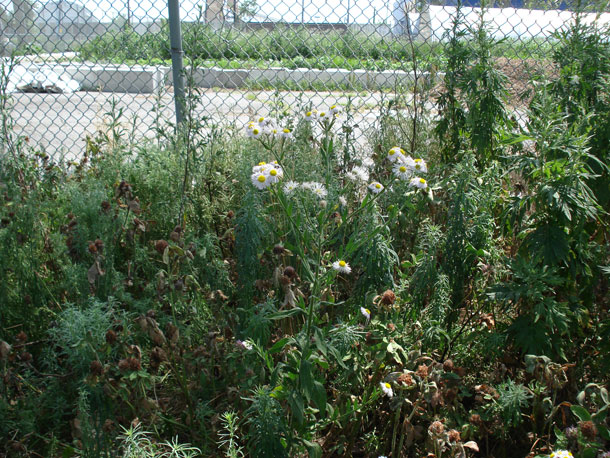
Fleabane is a spontaneous urban plant in the daisy family (Photo: Helen Palmer)
SEITER: Yes, the worst of them, and I think if you look at the plants that are on the invasive list here in New York State, you're looking at mugwort, Japanese knotweed, phragmites. Each of the plants really need to be studied, I think, further by botanists and urban ecologists to really understand and parse out what benefits those plants have and which ones they don't.
PALMER: So, taking that as your basis that there can be some benefits to these weeds, what I would call weeds, like mugwort, what would you call their benefits?
SEITER: They offer all sorts of ecological services. In certain conditions they would offer erosion control. They can offer noise mitigation. There's storm water management qualities that they can offer. If you look at, for example, common reed or phragmites, it's appearing in many places where traditionally we would've found cattails, right? Both plants have incredible filtering properties as plants themselves. The phragmites, although it establishes these rampant monocultures and does have degrading effects on more naturalized areas, at the same time it offers a lot of value in treating and filtering out the polluted water that it comes in contact with. So we really have to think site by site, where is that plant potentially going to do us good, and does that plant have the ability to kind of jump from an urban condition to a more naturalized condition. And perhaps the plants that are taking those leaps are the ones that we really should be looking at trying to eradicate. But the plants aren't here just because they want to be here, they're here because our conditions are degraded. We're not really fostering the native Northeast deciduous forest conditions, or here in New York the kind of tidal estuary conditions that we would've traditionally found. What we've created is a fully-altered, integrated system that the plants are really just responding to and kind of taking advantage of. I think spontaneous urban plants are actually giving us a great indicator of what plants might be successful in the future. Their resiliency in the urban environment really mimics the kind of resiliency that we're going to expect our plant life to have in the future.
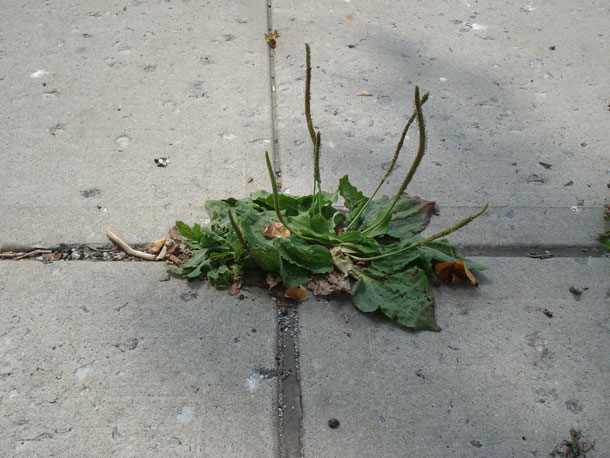
Broadleaf plantain sprouting in a sidewalk crack (Photo: Helen Palmer)
PALMER: Or we're going to need our plant live to have in the future in fact.
SEITER: Absolutely, and if we think about our cities and the different types of cities that we have, most of the rapidly growing cities are in our global south, in Asia, South America and those cities are hyper-dense and they're pretty much devoid of vegetation. So we want to look at every unique opportunity to kind of weave in, planted or unplanted landscapes to create more livable cities.
PALMER: A lot of these plants – as you say – you can eat them, though probably the ones that are growing on the sidewalk you wouldn't want to eat. But what other benefits do they have? You talk about their ability to soak up rainwater. You talk about their ability to clean up the soils.
SEITER: I think another thing that we should be thinking about is carbon sequestration. Although many ecologists will say you really need a forest of trees to be able to effectively sequester carbon in the urban environment, I would argue we have a forest of spontaneous trees that are really growing and they're not documented or mapped. Nobody's really understanding how many of them there are, so if we can start to lend a hand towards understanding that system in greater detail, I think we could make a case that they're actually performing great carbon-capturing effects.
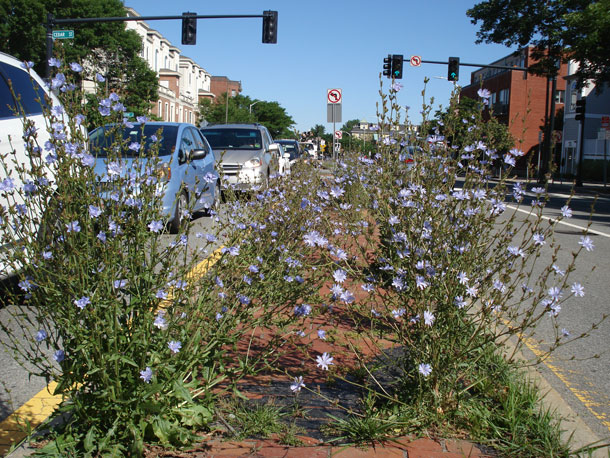
Chicory spontaneously grows up from the bricks along the median of Cambridge’s Massachusetts Avenue (Photo: Helen Palmer)
PALMER: So, things like the Tree of Heaven, the tree that grows in Brooklyn, but basically as reviled as weed trees, you would say are weed trees with a particular value.
SEITER: I would and I actually appreciate their aesthetic value as well. They're kind of wonky, gnarled trees that have a particular character and quality so again, on the right site I think that they're really effective plants.
PALMER: Do you find that, in fact, the authorities agree with the value of what you call urban plants, what other people call weeds?
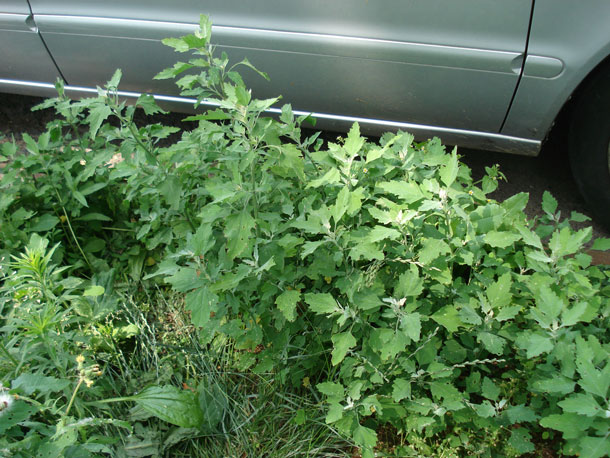
Lamb’s quarters growing along a Brooklyn sidewalk (Photo: Helen Palmer)
SEITER: It's a topic that they're beginning to be more receptive to. One of the biggest things that is facing New York City parks here in general is that each park gets a grade from the kind of central dispatcher about how well their park is maintained, and unfortunately one of the biggest qualifying factors is the amount of weeds that are present. So, the parks has unfortunately set up this system where weeds are essentially looked at negatively. I was recently in discussion with the head of horticulture for the New York City parks and she was really open and receptive to the idea of certain wild, urban plants growing in parks but she was worried about the public perception of those plants because when people see overgrown weedy landscapes they think it's derelict or neglected, and parks management officials are essentially given poor management grades when weeds are allowed to kind of grow in their parks. So, if we're going to rethink weeds themselves, I think we will also need to get our parks department to rethink how they're valuing the management of their open spaces.
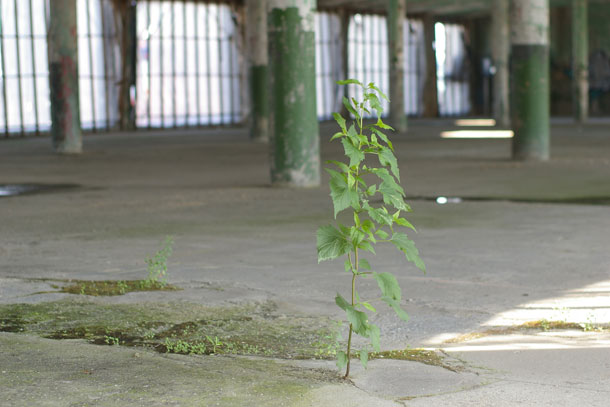
Ageratina altissima or White Snakeroot (Photo: Future Green Studio)
PALMER: If you actually rethink weeds you can actually see that the beauty of them, the benefits of them and actually remake our landscape?
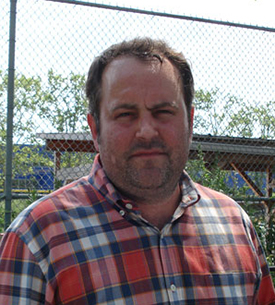
David Seiter is design director and founding principal of Future Green Studio in Brooklyn, New York. (Photo: Helen Palmer)
SEITER: Yes, I think we have the potential to do all of that. I mean, again, our perception of weeds are just really like a cultural perception. There's no particular reason why many of these plants are called weeds except they are kind of growing in places that we don't necessarily want them to grow. So if we just kind of expand our definition of what's acceptable, I think that we'll find many of these plants offer this kind of hidden or overlooked ecology to the city.
PALMER: My mother used to say, “a weed is just a plant in the wrong place.”
SEITER: Absolutely. And then in my own little Brooklyn backyard I find a fig buttercup drifting in white snake roots. These plants that are spontaneously growing but that I appreciate the value of and create this kind of carpet of yellow and white and red throughout the seasons. So I’m teaching my own kids to think about the value of those particular plants.
CURWOOD: That’s landscape architect David Seiter, in Brooklyn with Living on Earth’s Helen Palmer. His book is called "Spontaneous Urban Plants, Weeds in NYC.”
Links
Living on Earth wants to hear from you!
Living on Earth
62 Calef Highway, Suite 212
Lee, NH 03861
Telephone: 617-287-4121
E-mail: comments@loe.org
Newsletter [Click here]
Donate to Living on Earth!
Living on Earth is an independent media program and relies entirely on contributions from listeners and institutions supporting public service. Please donate now to preserve an independent environmental voice.
NewsletterLiving on Earth offers a weekly delivery of the show's rundown to your mailbox. Sign up for our newsletter today!
 Sailors For The Sea: Be the change you want to sea.
Sailors For The Sea: Be the change you want to sea.
 The Grantham Foundation for the Protection of the Environment: Committed to protecting and improving the health of the global environment.
The Grantham Foundation for the Protection of the Environment: Committed to protecting and improving the health of the global environment.
 Contribute to Living on Earth and receive, as our gift to you, an archival print of one of Mark Seth Lender's extraordinary wildlife photographs. Follow the link to see Mark's current collection of photographs.
Contribute to Living on Earth and receive, as our gift to you, an archival print of one of Mark Seth Lender's extraordinary wildlife photographs. Follow the link to see Mark's current collection of photographs.
 Buy a signed copy of Mark Seth Lender's book Smeagull the Seagull & support Living on Earth
Buy a signed copy of Mark Seth Lender's book Smeagull the Seagull & support Living on Earth

